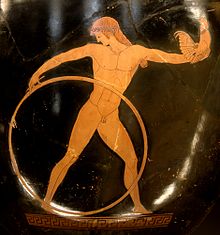Mature (toy)

The hoop , seldom also called hoop , is a toy that is used to promote dexterity in many cultures around the world. It used to be made almost exclusively of wood by hand and has been known since the 1950s, especially in its shape made of plastic tubing, as a hula hoop .
history
Already in the Corpus Hippocraticum in the text On the way of life (around 400 BC) running a tire is recommended. People with weak constitution should use this exercise to restore their health. Artemidoros , a fortune teller from the 2nd century, means in his dream interpretation work : To drive a tire means that one is subjected to efforts from which the dreaming will benefit.
With the Indians of North America and the Eskimos, the tire was used to learn the hunting techniques necessary for survival in a playful way. Someone was driving a tire and others were throwing long poles through the opening. Or a hoop braided with straps was rolled past a row of young archers and the arrows could then be used to determine the winner.
In the 19th century, the use of light wooden tires was common practice for boys and girls. Regular races were held, and although the somewhat stiff and strict clothing of the upper class did not seem to go with it at all, the young aristocracy also passed their time with it.
The tire experienced a rebirth as a toy in the late 1950s and early 1960s when it returned to children's rooms in plastic form, marketed by Wham-O as hula hoops.
Tire drift
The tire driving looks easy to the spectator, but it takes a lot of practice and skill to hold the tire upright and move it forward. A small stick (or rod) is used for driving, to which a small wooden ball was often attached for decoration. But even without a stick, just using the palm of your hand, you can move the tire forward after holding it vertically and then giving it a slight forward blow on the upper curve. The curve technique again places special demands on leg-hand-eye coordination. In this context, the tire is also called Tunnband, Trünnelband, Trudelreifen, Trudelband or Tüdelband in North German usage (Low German ). The Wolf brothers sang this game in the couplet An de Eck steiht'n Jung mit'n Tüdelband . In Bremen, the expression “Tombandlauf” has been handed down and indicates that the material of such a tire was, in addition to wood (especially willow wood, see tape tearer ), in the past, the iron of barrel tapes, i.e. the old retaining rings of wooden barrels and vats. In this function, they were replaced by bicycle rims without spokes and hubs.
Hula hoop
The well-known exercise of dexterity, letting a light tire circle around the waist, became a fashion game that was widespread worldwide when, from July 1958, the Californian toy manufacturer Wham-O Corp. , Supported by a national marketing campaign in less than four months 25 million plastic tires deposed under the name hula hoop on the American market ( Hula for Hawaiian dance and hoop English. (Barrel) tires ; now marketed as "Hula Hoop®") . In the same year the wave swept to Germany, where these tires were manufactured for the first time by the company geobra Brandstätter . Children and adults invented tricks with the plastic device. Permanent hula hooping was one of the simplest competitive disciplines to which young people and adults also submitted. In variety shows and circuses , artists could be seen juggling dozens of hoops around their necks and tummy. Orthopedic surgeons increasingly treated intervertebral disc problems, especially older hula hoopers. The title of the German comedy Hula-Hopp, Conny (1959) with Cornelia Froboess and Rex Gildo was a quick response to this fashion.
Other techniques
Relay races over several hundred meters (there and back), with the same tire serving as the baton, can also be carried out at festivals. There are no limits to the wealth of ideas. Jumping through the hoop or throwing objects through the middle are just a few games that kids will instantly think of. Rhythmic gymnastics can serve as a stimulus . There, the competitors use the tire in a spectacular way (e.g. throwing your foot and catching your neck, etc.).
The hula hoop can also be used for a sporty workout. Training with a fitness hoop supports the cardiovascular system, strengthens the core muscles, stimulates the fat metabolism and improves coordination. There are various exercises that can be combined with elements from aerobics, Pilates, yoga, dance and body workout. The various hoop techniques are easy to learn with a little practice. The body saves the exercise program and can more easily call it up again with a short break.
Boy in sailor suit with wooden hoops, around 1902–1905
literature
- Games of the World II , edited by Eugen Oker , Fischer Taschenbuch, Frankfurt 1985, ISBN 3-596-23075-6
- Walter Seiler: Old children's games in Switzerland. A collection of ethnographic movement games ; Reprint of the Swiss teachers 'newspaper, "Schulpraxis" issue, monthly of the Bern Teachers' Association, FSVO, No. 25, June 21, 1979, Bern
Web links
- Article on the history of the tire at Spielzeuggeschichten.de
- Everything about hula hooping - exercises, hoops and much more.
Individual evidence
- ↑ Corpus Hippocraticum De diaeta 63-92.
- ^ Alfred Cammann: The world of Low German children's games , 1970, pp. 38, 93, 205, 306
- ↑ http://www.plattmaster.de/andeeck.htm
- ↑ Article en: Wham-O on the English language Wikipedia









